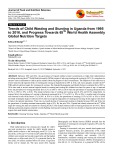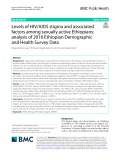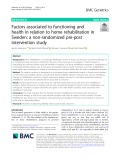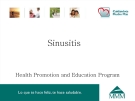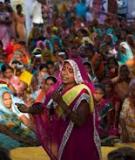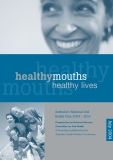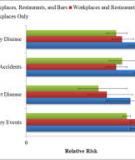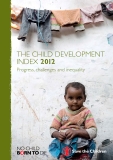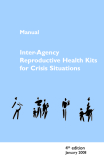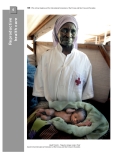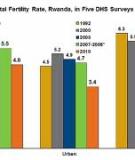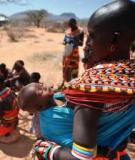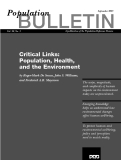
Demographic and Health Program
-
Between 1995 and 2016, the government of Uganda ratified several commitments to fight child undernutrition including achieving the 65th World Health Assembly (WHA) targets of reducing stunting and wasting by 2025. It is important we monitor such commitments to inform policy makers about the progress of their commitments.
 6p
6p  viisac
viisac
 23-09-2023
23-09-2023
 5
5
 1
1
 Download
Download
-
The reduction of stigma and discrimination in a population are important indicators of the success of programs that target HIV prevention and control. This study aimed to assess the level of HIV-related stigma and its determinants among sexually active Ethiopians.
 11p
11p  viferrari
viferrari
 28-11-2022
28-11-2022
 11
11
 2
2
 Download
Download
-
Iran’s population is aging. Disability is a major public health problem for older adults, not only in Iran but all over the world. The purpose of this study was to investigate the relationship between cardio-metabolic and socio-demographic risk factors and disability in people 60 years and older in Iran.
 9p
9p  viisaacnewton
viisaacnewton
 25-04-2022
25-04-2022
 16
16
 5
5
 Download
Download
-
Home rehabilitation is a growing rehabilitation service in many countries, but scientific knowledge of its components and outcomes is still limited. The aim of this study was to investigate; 1) which changes in functioning and self-rated health could be identified in relation to a home rehabilitation program in a population of community-dwelling citizens, and 2) how socio-demographic factors, health conditions and home rehabilitation interventions were associated to change in functioning and self-rated health after the home rehabilitation program.
 11p
11p  vinobelprisen
vinobelprisen
 26-03-2022
26-03-2022
 10
10
 4
4
 Download
Download
-
Hepatitis B virus (HBV) infection is a global public health problem. There is wide variation in seroprevalence of HBV infection. Majority of these infections are chronic and asymptomatic leading to complications like cirrhosis and hepatocellular carcinoma. Aim of the study is to determine seroprevalence of HBV among patients who were attending a tertiary care hospital at Mumbai and to study their demographic features. Patients attending outpatient Department and inpatient Department who were advised for HBsAg testing were included in the study.
 5p
5p  kethamoi6
kethamoi6
 29-06-2020
29-06-2020
 17
17
 1
1
 Download
Download
-
Over the past four decades, the World Health Organization established the Expanded Programme on Immunization (EPI) to foster universal access to all relevant vaccines for all children at risk. The success of this program has been undeniable, but requires periodic monitoring to ensure that coverage rates remain high.
 12p
12p  vidr2711
vidr2711
 19-02-2020
19-02-2020
 16
16
 0
0
 Download
Download
-
Kenya National Bureau of Statistics (KNBS) and ICF Macro. 2010. Kenya Demographic and Health Survey 2008-09. Calverton, Maryland: KNBS and ICF Macro. Comments Percentage of breastfed babies receiving complementary foods at 6-9 months of age reduced from 84.2% (2003) to 82.8% (2008/09). However, it is important to note that 32% of babies are introduced to complementary feeds too early at the age of 2-3 months; this malpractice has however improved over time from 81% (1993) to 32% (2008/09).
 20p
20p  seketnoi
seketnoi
 28-04-2013
28-04-2013
 45
45
 3
3
 Download
Download
-
This report presents preliminary findings from the 2010 Rwanda Demographic and Health Survey (2010 RDHS). Survey findings will be used by policy makers to evaluate the demographic and health status of the Rwandan population in order to formulate appropriate population and health policies and programs in Rwanda. The forthcoming final report and summary report of the RDHS will contain more detailed findings.
 41p
41p  nhamnhiqa
nhamnhiqa
 01-03-2013
01-03-2013
 44
44
 1
1
 Download
Download
-
Three questionnaires were used for the 2010 RDHS: the Household Questionnaire, the Women’s Questionnaire, and the Men’s Questionnaire. These questionnaires are based on questionnaires developed by the worldwide Demographic and Health Surveys (DHS) program and on the questionnaires used during the 2005 RDHS and 2007-08 RIDHS surveys. To reflect relevant issues in population and health in Rwanda, the questionnaires were adapted during a series of technical meetings with various stakeholders from government ministries and agencies, non-governmental organizations and international donors.
 77p
77p  nhamnhiqa
nhamnhiqa
 01-03-2013
01-03-2013
 46
46
 1
1
 Download
Download
-
The 2010 Rwanda Demographic and Health Survey (2010 RDHS) was carried out by the National Institute of Statistics of Rwanda (NISR) and the Ministry of Health (MoH). ICF Macro provided technical assistance to the project through the MEASURE Demographic and Health Surveys program (MEASURE DHS).
 146p
146p  nhamnhiqa
nhamnhiqa
 01-03-2013
01-03-2013
 43
43
 2
2
 Download
Download
-
One-time reports also provide Child Health program indicator results e.g., National Survey of Parents of Young Children (66) http://www.investinkids.ca/parents/about-us/ourresearch/articletype/articleview/articleid/1258/ national-survey-of-parents-of-young-children.aspx and Ontario Incidence Study of Reported Child Abuse and Neglect [OIS], 2003 (117) http://www.phac.arpc.gc.ca/publicat/cissr-ecirc/pdf/cmic_e.
 36p
36p  nhamnhiqa
nhamnhiqa
 01-03-2013
01-03-2013
 45
45
 2
2
 Download
Download
-
USAID’s APHIA plus platforms; CDC’s on-going population-based surveillance such as the western Kenya Health and Demographic Surveillance System (HDSS) and the Kibera-based population-based surveillance site; and the Dadaab and Kakuma refugee camps (of note, refugees are often excluded from national policies and programs, to the detriment of the health of refugees and their host communities). These platforms, in particular the population-based surveillance platforms, offer the capacity to precisely measure inputs and outcomes, including interim and proxy indicators.
 0p
0p  nhamnhiqa
nhamnhiqa
 01-03-2013
01-03-2013
 43
43
 1
1
 Download
Download
-
Nepal has witnessed massive political upheaval during the past decade with insurgency forces actively expressing dissatisfaction with the existing status quo. It was in early 1996 that the Maoist insurgency took root in the country exerting a tremendous influence on the social, economic and political life of the country. The constant conflict forced the Nepalese people to migrate from rural to urban areas and to neighboring countries, resulting in the displacement of a large proportion of the population and impacting the demographic situation.
 44p
44p  thankinhphanliet
thankinhphanliet
 21-12-2012
21-12-2012
 47
47
 4
4
 Download
Download
-
Subsequently, the 1996 Nepal Family Health Survey, the 2001 Nepal Demographic and Health Survey and the 2006 Nepal Demographic and Health surveys were conducted. This trend report discusses key findings from these three DHS surveys in Nepal. All three Nepal DHS surveys sampled nationally representative populations, were conducted by the same organization (New ERA Ltd.), and managed by the same core group of survey personnel.
 174p
174p  thankinhphanliet
thankinhphanliet
 21-12-2012
21-12-2012
 57
57
 9
9
 Download
Download
-
One of the most significant contributions of the MEASURE DHS program is the creation of an internationally comparable body of data on the demographic and health characteristics of populations in developing countries. The DHS Comparative Reports series examines these data across countries in a comparative framework. The DHS Analytical Studies series focuses on specific topics. The principal objectives of both series are to provide information for policy formulation at the international level and to examine individual country results in an international context.
 62p
62p  thankinhphanliet
thankinhphanliet
 21-12-2012
21-12-2012
 38
38
 3
3
 Download
Download
-
These are only some of the outcomes that will be achieved through the GHI. For a complete list of GHI targets and outcomes, including linkages to current strategies, see Annex A. Through GHI, the U.S. seeks to align goals and targets for our investments with partner country needs, plans and pri- orities. These goals and targets build upon our existing health programs as we work with countries to achieve signifi- cant and sustainable gains in health.
 12p
12p  le_minh_nha
le_minh_nha
 20-12-2012
20-12-2012
 50
50
 4
4
 Download
Download
-
The Alabama Autism Surveillance Program (AASP) is a multisource investigation to monitor the number of 8-year- old children in the population with ASDs or cerebral palsy, or both. This surveillance system provides an accurate count of the number of children and families residing in Alabama living with these disorders. The investigators are members of the Department of Health Care Organization and Policy in the School of Public Health at the University of Alabama at Birmingham (UAB), working as agents of the Alabama Department of Public Health.
 0p
0p  can_thai
can_thai
 12-12-2012
12-12-2012
 44
44
 1
1
 Download
Download
-
The regulations mandate that health plans provide enrollees with translated vital documents (for example, explanations of benefits) and ensure the availability of interpreter services at all points of patient contact, including clinical encounters (DrTango Inc. n.d.). Services must be provided at no cost to the enrollee. To guide the development of these services, plans must collect patient demographic data, including language information gathered through a patient survey. 3 Health plans also must monitor their language service programs to track plan and provider compli- ance.
 632p
632p  quygia123
quygia123
 02-11-2012
02-11-2012
 42
42
 3
3
 Download
Download
-
Roger-Mark De Souza is the technical director of the population, health, and environment program at the Population Reference Bureau. His responsibilities include designing, managing and implementing policy research, capacity building, technical assistance, and media projects in developing countries. De Souza holds graduate degrees from the George Washington University and the University of the West Indies. John S. Williams, a demographer at the Population Reference Bureau, specializes in population, environment, and community programs.
 48p
48p  yeurauxanh88
yeurauxanh88
 28-09-2012
28-09-2012
 84
84
 6
6
 Download
Download
CHỦ ĐỀ BẠN MUỐN TÌM








